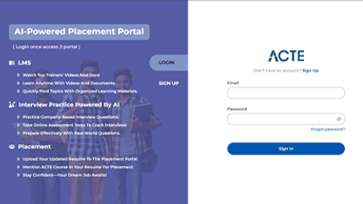In Our ACTE Institute, The Web Designing Course provides students with a comprehensive overview of web design principles. This course covers topics such as digital graphics, layout and typography, HTML and CSS coding, usability and accessibility, web page creation, and search engine optimization. The course teaches students the necessary skills to create and maintain a professional website. Furthermore, it covers the fundamentals of web hosting and domain registration. By the end of the course, students will be able to create an engaging and well-crafted web presence for their business or organization. ACTE Software training institute in Bangalore, we provide professional certificates with On field Trainers teaching flexible timings for our students, this Web designing course is our most popular course in Bangalore city.
Additional Info
Why Web Designing Training in Bangalore from ACTE?
ACTE is one of the most reliable names when it comes to Web Designing Training in Bangalore. With a team of experienced trainers and updated course curriculum, ACTE provides the best web designing training in Bangalore. The course content is designed to meet the needs of the industry and the training is conducted in a real time environment with the help of expert trainers. The training also covers the fundamentals of web design and development, the best practices and techniques, and the use of the latest tools. In addition, the course also provides hands-on experience on live projects and helps students to understand the importance of web designing in the business world.
What is the Qualification to Learn the Web Designing Course?
The qualification to learn web design varies depending on the program and the institution. Generally, students should have a high school diploma or its equivalent. Additionally, some programs may require applicants to have prior experience with HTML, CSS, and other coding languages. It may also be necessary for applicants to pass a technical assessment or demonstrate proficiency in web design.
The basic educational qualification to learn Web Designing is a High School Diploma or equivalent. Those who have completed a Bachelor's degree in Computer Science, Information Technology, Software Engineering, or a related field may have a better understanding of the concepts of Web Design. Additionally, it is important to have a basic understanding of HTML, CSS, JavaScript, and other web technologies.
Why Do We Need to Choose a Web Designing Course for Our Career?
A web designing course is essential to pursue a career in web design because it provides a comprehensive understanding of the tools and techniques used to create effective web designs. It covers topics such as HTML, CSS, JavaScript, user experience, graphic design, and more. These skills are critical for creating modern, user-friendly websites. Furthermore, a web design course will also teach you how to create content for websites and make sure that your designs are optimized for search engine optimization (SEO). This will help you to stand out from the competition and make sure your website is seen by potential customers.
web designing is a growth area for career development. Web design offers many opportunities for people to develop their skills and knowledge in the field and become successful in their careers. Web design is a rapidly growing industry, and those who have the necessary skills can find many job opportunities.
What are the Prerequisites for Web Design?
The prerequisites for web design depend on the level of expertise required for a particular project. For basic web design, basic computer skills, some knowledge of HTML and CSS, and an understanding of how the web works are required. For more advanced web design, knowledge and experience with web development frameworks, such as JavaScript, MySQL, and PHP, may be necessary. In addition, experiences with image editing software, like Adobe Photoshop, and familiarity with web hosting and server management are also important.
- Knowledge of HTML and CSS: HTML and CSS are the two main coding languages that are used to create websites. A good knowledge of HTML and CSS is essential for web design.
- Knowledge of JavaScript: JavaScript is a programming language used to create interactive elements on a website.
- Knowledge of graphic design: Graphic design is important for creating an attractive and eye-catching website.
- Knowledge of web standards: Web standards include guidelines for the design and development of websites.
- Creativity: Creativity is essential for developing unique and interesting web designs.
- Attention to detail: Attention to detail is important when it comes to making sure the website looks and functions correctly.
- Patience: Web design can be a time-consuming and challenging process, so patience is a must.
- Good communication skills: Good communication skills are essential for working with clients and other members of a web design team.
Is Web Design the Best Choice for Growth?
web design is a great choice for career growth. It is a rapidly growing field with a wide range of opportunities, from freelance work to full-time positions. It requires a deep understanding of both design and technical skills, and the ability to use them to create modern, functional websites that meet the needs of their users. Web design allows you to be creative, develop problem-solving skills, and gain insight into the latest technologies. The possibilities are endless, and the potential for growth is enormous.
Current Trending Technologies in Web Designing:
- Responsive Design: Responsive design is a must-have feature for modern web design. It enables a website to be viewed and used on all devices, from desktops to phones, tablets, and TVs.
- Minimalism: Minimalism is a popular trend in web design, where the focus is on stripping away unnecessary elements and focusing on a simple, clean look.
- Bold Typography: Bold typography is a great way to draw attention to important content, as well as set the mood for a website.
- Dynamic Backgrounds: Using dynamic backgrounds, such as video, is becoming increasingly popular among web designers.
- Storytelling: Storytelling is becoming an important part of web design, as it helps to connect with the user and make them feel more invested in the website.
- 6. Animations: Animations are another popular trend in web design, as they can help to make a website more engaging and interesting.
Future Scope of Web Designers:
Web designers will continue to play an important role in the development and design of websites, as the demand for web-based services and products continues to grow. In the future, web designers may need to become more specialized, focusing on specific areas such as mobile web design, e-commerce design, and social media integration. Additionally, web designers may need to become proficient in other technologies, such as HTML5, CSS3, and JavaScript, as well as more advanced programming languages. As the demand for websites continues to rise, web designers will be needed to create innovative and efficient websites that meet the needs of customers.
HTML is the foundation of any website and is used to create the structure of your website. CSS: CSS is used to style the look and feel of your website. JavaScript: JavaScript is used to add interactivity to your website. Responsive Design: Responsive design is the process of ensuring that your website looks good on any device. Accessibility: Accessibility is the process of making sure your website is usable by people with disabilities. SEO: SEO stands for search engine optimization, which is the process of optimizing your website for search engines like Google. Usability: Usability is the process of making sure your website is easy to use for your visitors. Security: Security is the process of making sure your website is secure from hackers and other malicious attacks.
- Ability to Create Customized and Engaging Websites: One of the primary advantages of hiring a web designer is that they have the skill and experience to create customized and engaging websites that stand out from the competition.
- Improved User Experience: A web designer can also help improve the user experience by developing a website that is easy to navigate and understand.
- Optimized for Search Engines: Web designers are also experienced with optimizing websites for search engines, which can help websites rank higher in search engine results.
- Increased Conversion Rates: By creating a website that is user-friendly and optimized for search engines, web designers can help businesses increase their conversion rates.
- Professional Appearance: Hiring a web designer can also help businesses create a professional and polished look for their website, which can help create a positive impression with visitors.
Web Designers Responsibilities:
Web developers are the Most demanded persons in IT industries, who is learned the web designing with professional certification. There are some responsibilities for the web designers,
- Developing the overall layout and design of a website.
- Working with clients to create a website that meets their needs and goals.
- Ensuring the website is user-friendly and visually appealing.
- Take into account search engine optimization when designing the website.
- Creating content for the website, such as text, images, videos, and audio.
- Updating and maintaining existing websites.
- Troubleshooting technical issues related to the website.
- Integrating various web technologies, such as HTML, CSS, JavaScript, and Flash.
- Working with UX/UI designers to create a user-friendly interface.
- Testing the website for usability and compatibility with different browsers and devices.
How Did You Get the Web Designers Job Role in Industries?
I began my career as a web designer by taking on freelance web design projects for small businesses. I then enrolled in a web design class and gained certification. After that, I began looking for full-time web design jobs and applied to several companies. After completing multiple interviews, I was eventually offered the web design job role.
- Get certified: One of the best ways to gain credibility in the field of web design is by earning certifications in the areas of web design and development.
- Learn the fundamentals: Brush up on HTML, CSS, and JavaScript. These are the building blocks of web design.
- Acquire relevant experience: Take on freelance web design projects, or volunteer to work on websites for friends and family members.
- Network: Attend web design events and connect with other web designers and developers.
- Showcase your portfolio: Create an online portfolio to showcase your work, and include links to your best web design projects.
- Apply for web design jobs: Search for web design jobs online, and submit your resume and portfolio to employers.
Web Designer's Salary in Current IT Industries:
The salary for web designers in the current IT industry varies greatly depending on experience, qualifications, and location. Generally, entry-level web designers can expect to earn between $35,000 and $50,000 per year. Experienced web designers can earn upwards of $75,000 per year. Salaries for highly-skilled web designers can reach into the six figures.
The average salary for web designers in the current IT industry is around $65,000 to $80,000 yearly. This range can vary depending on experience, the size of the company, and the industry. Web designers in larger companies may earn higher salaries, while those in smaller companies may be paid less. Web designers also tend to earn more in cities with a higher cost of living. Additionally, web designers may receive bonuses or performance-based pay for their work.
Web Designer's Skill Sets for their Jobs:
- Graphic Design: Ability to create compelling visuals, typography, and imagery to convey a message.
- User Experience Design: Understanding of user needs and how to design for them.
- Web Programming: Knowledge of HTML, CSS, JavaScript, and other web-programming languages.
- Mobile Design: Understanding how to design for mobile devices and various screen sizes.
- Database Design: Ability to design and implement a database for efficient data storage and retrieval.
- Project Management: Skills in managing the development of a website, from concept through launch.
- Search Engine Optimization: Knowledge of how to optimize web pages and content for search engine rankings.
- Digital Marketing: Understanding of digital marketing strategies, such as email campaigns, social media, and content marketing.
Important Daily To-Dos List for Designers:
1. UX/UI Design: UX/UI design is the process of designing user interfaces for websites and web applications in order to make them easier to use and more engaging for the user. This includes creating wireframes, mockups, and prototypes, as well as researching and designing user-friendly navigation systems and user flows.
2. Front-End Development: Front-end development is the process of creating the visual elements of a website, such as a layout, design, and user interface. This includes creating HTML, CSS, and JavaScript code to make websites look and behave in the way the designer envisions.
3. Graphic Design: Graphic design is the process of creating visual elements, such as logos, images, and illustrations, that can be used in various digital and/or print projects. This includes creating layouts, typography, and brand identity, as well as understanding color theory, composition, and image file formats.
4. Content Writing: Content writing is the process of creating written content for websites, blogs, and other digital media. This includes researching topics, creating copy, and optimizing content for SEO purposes.
5. SEO: SEO is the process of optimizing websites for search engine rankings. This includes researching keywords, creating meta tags, and optimizing content for better search engine visibility.
Online Classes:
Our ACTE Provides Online courses that offer flexible scheduling options, allowing you to complete the course at your own pace. You can easily fit coursework into your busy schedule, no matter the time of day or night. Variety of Courses: With online courses, you can choose from a wide variety of web design courses. Whether you are looking for basic HTML and CSS courses or more complex coding options, you can find the right course for your needs. Affordable: Online courses are typically much more affordable than traditional courses. Many courses are even offered for free, allowing you to save money while learning. Networking Opportunities: By taking a web design course online, you can meet and connect with other web designers from around the world. This can be a great way to get ideas and advice from experienced professionals.































